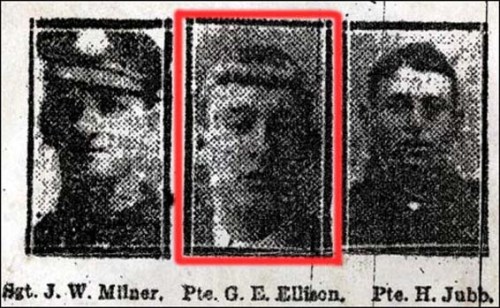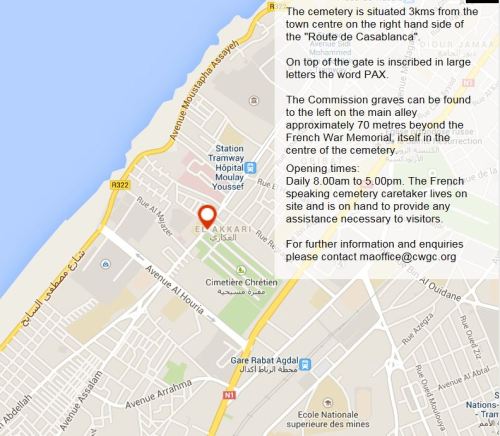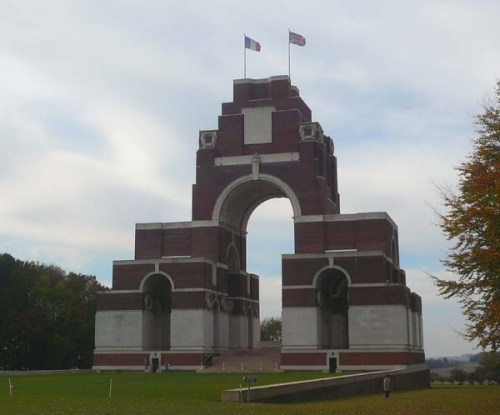Let me first say that it is not really my intention to offend anybody by my views in this blog post, but I believe that many uncomfortable truths about the Great War are quite simply ignored because they are so unpalatable, and it is far more convenient just to forget them.
Most people, therefore, are completely unaware that at the end of the Great War, inanely and insanely, combat continued right up until 11.00 a.m. on that very last day, November 11th 1918, even though it had been widely known for five or six hours across the whole world that hostilities would soon cease, and despite the fact that the war had already claimed an enormous number of lives.
On the Allied side there had already been 5,525,000 soldiers killed and 4,121,000 missing in action. A total of 12,831,500 soldiers had been wounded, including both of the veterans that I myself had the privilege of knowing. In the east, the Russian Empire had suffered casualties of 3,394,369 men killed with as many as 4,950,000 wounded. On the side of the Central Powers, 4,386,000 soldiers were killed and 3,629,000 were missing in action. A total of 8,388,000 soldiers were wounded.

In total, Allied casualties were 22,477,500 and for the Central Powers the figure was 16,403,000. Overall, that is 38,880,500, roughly the current population of Poland, or a total more than Canada (35 million) or Belgium and Australia combined. Presumably, a few more pointless deaths on the last day were not seen as being particularly important.

The last to arrive in the carnage of the Great War, of course, had been the Americans, but they soon began to waste their poor young “Doughboys” lives in the same way as their more experienced allies had already done for three long years.

In the first four hours in the Argonne Forest, for example, they lost more men than they were to lose on D-Day. Indeed, the Meuse-Argonne was “probably the bloodiest single battle in U.S. history,” with the largest number of U.S. dead, at more than 26,000. Hopefully, this blood soaked struggle is not as forgotten as many websites claim, and if the Argonne War Cemetery, which contains the largest number of American military dead in Europe (14,246) is apparently often ignored by the tourist coaches, then it clearly should not be. Overall, the American casualties in the Great War were to number 117,465 men.

Negotiations to end hostilities had actually begun on November 8th but Marshall Foch, the Commander-in-Chief of the Allied Armies, refused to stop the war, because of fears that the German delegation, led by Matthias Erzberger, were not totally sincere in their desire for peace.
 This was after Foch’s own country had lost 1,737,800 men killed. The story is told by Joseph E.Persico…
This was after Foch’s own country had lost 1,737,800 men killed. The story is told by Joseph E.Persico…
“On average, 2,250 troops on all sides were dying on the Western Front every day. “For God’s sake, Monsieur le Maréchal,’ Erzberger pleaded, ‘do not wait for those seventy-two hours. Stop the hostilities this very day.’ The appeal fell on deaf ears. Before the meeting, Foch had described to his staff his intention “to pursue the Feldgrauen (field greys, or German soldiers) with a sword at their backs” to the last minute until an armistice went into effect.”
So, the next day, November 9th, the Canadians attacked Mons and General Currie, helped by the men of the Canadian Infantry Brigade, captured the town during the night of November 10th-11th. As for the Americans…
“Late on November 9th, instructions from the Allied Commander-In Chief were transmitted, directing a general attack, which was executed by the First Army on November 10th-11th. Crossings of the Meuse were secured by General Summerall’s (V) Corps during the night of November 10th-11th and the remainder of the army advanced on the whole front.”

Summerall’s actions on November 10th-11th resulted in more than eleven hundred American casualties, mainly in the Marine Corps.
All of this military action took place despite the fact that the Armistice had already been signed at 5:10 a.m. on the morning of November 11th. Within minutes of the signing, news of the cease fire had been transmitted all around the world. The “war to end all wars”, was finally over. And every general and every high ranking officer knew this. They were all aware of what had happened that day at 5.10 a.m., a time which was then backed up officially to 5.00 a.m.
Even the primitive technology of the day allowed the wonderful news to be in every major city by 5.30 p.m. and celebrations began in the streets well before most soldiers were aware of the end of hostilities.
Except that technically, the “war to end all wars”, was not yet actually over, because the cease-fire was not to come into effect until Foch’s deadline: the eleventh month, the eleventh day and the eleventh hour of 1918. In this way all the soldiers in the trenches would be completely sure of being told the news that the conflict had finished.

For this reason General William M. Wright thought it would be a fine idea for the American 89th Division to attack the tiny village of Stenay in north-eastern France only hours before the war ended.

A total of 365 men died because, in Wright’s words,
“the division had been in the line a considerable period without proper bathing facilities, and since it was realized that if the enemy were permitted to stay in Stenay, our troops would be deprived of the probable bathing facilities there.”
Indeed, the Americans were to take heavy casualties on the last day of the war. This was because their commander, General John Pershing, believed that the Germans had to be severely defeated at a military level to effectively “teach them a lesson”. Pershing saw the Armistice as being too soft. He supported the commanders who wanted to attack German positions – even though he knew that an Armistice had been signed.

It says it all perhaps to reveal the detail that the French commander of the “80th Régiment d’Infanterie” received two simultaneous orders on that morning of November 11th. The first was to launch an attack at 9.00 a.m., the second was to cease fire at 11.00 a.m..
The last British soldier to die in the Great War seems to have been Private George Edwin Ellison, who was killed at 9.30 a.m. after serving a full four years on the Western Front. He was forty years of age, and had seen combat on the very first day of the conflict.

A soldier in the 5th Royal Irish Lancers, Ellison was scouting on the outskirts of the Belgian town of Mons where German soldiers had been reported in a wood. In just ninety minutes or so, the war would be over and George Ellison, an ex-coal miner and the son of James and Mary Ellison, would go back to 49, Edmund Street, in Leeds, to his wife Hannah Maria and their four-year-old son James. And then a rifle shot rang out, and George was dead. He would never go home to his loving family, but would rest for ever in St.Symphorien Military Cemetery.
This slideshow requires JavaScript.
The last French soldier to be killed was Augustin Trebuchon from the “415th Régiment d’Infanterie”. He was a runner and was taking a message to his colleagues at the front telling them of the ceasefire. He was hit by a single shot and killed at 10.50 a.m. Some seventy five French soldiers were killed on the last half-day of the war but their graves all give November 10th as the date of death. Optimists believe the reason for this discrepancy was that by stating that these men had died well before the end of the war, their family would be guaranteed a war pension. Realists believe that the government wanted to avoid any political scandal if it ever became known that so many brave men had died so pointlessly on the last day of the conflict.

The last Canadian to be killed was Private George Lawrence Price of the Canadian Infantry (Second Canadian Division) who died, like Englishman George Ellison, at Mons in Belgium. Private Price was killed at 10.58 a.m., and he was officially the last Commonwealth casualty in the Great War. So Private Price would never be going home to Port Williams, in Nova Scotia to see again his loving parents, James and Annie Price. Instead their wonderful son would rest for ever in St.Symphorien Military Cemetery, just a short distance from the grave of Private George Ellison.

The last American soldier to be killed was Private Henry Gunter who was killed at 10.59 a.m, one minute later than Private Price, the Canadian. A Private from Baltimore, ironically, of German ancestry, Gunter was officially the last Allied soldier to die in the Great War.
According to Joseph E.Persico…
“His unit had been ordered to advance and take a German machine gun post. It is said that even the Germans – who knew that they were literally minutes away from a ceasefire – tried to stop the Americans attacking. But when it became obvious that this had failed, they fired on their attackers and Gunter was killed. His divisional record stated: “Almost as he fell, the gunfire died away and an appalling silence prevailed.”
Again according to Joseph E.Persico,
“The last casualty of the Great War seems to have been a junior German officer called Tomas who approached some Americans to tell them that the war was over and that they could have the house he and his men were just vacating. However, no one had told the Americans that the war had finished because of a communications breakdown and Tomas was shot as he approached them after 11.00 a.m.”
The total British Empire losses on the last day of the war were around 2,400 dead. Total French losses on that day amounted to an estimated 1,170. The Americans suffered more than 3,000 casualties, and the Germans lost 4,120 soldiers.
Indeed, Armistice Day, with its ridiculous totals of killed, wounded or missing, exceeded the ten thousand casualties suffered by all sides on D-Day, some twenty six years later. There was a crucial difference however. The men beginning to liberate Western Europe on June 6th, 1944, were risking their lives to win a war. The men who died on November 11, 1918, were losing their lives in a war that the Allies had already won.
This account occurs on an American website……
“When the American losses became public knowledge, such was the anger at home that Congress held a hearing regarding the matter. In November 1919, Pershing faced a House of Representatives Committee on Military Affairs that examined whether senior army commanders had acted accordingly in the last few days of the war.”
The story is continued on another website….
“Bland, the other Republican on Subcommittee 3, knifed quickly to the heart of the matter when his turn came to question General Conner.
“Do you know of any good reason,” Bland asked, “why the order to commanders should not have been that the Armistice had been signed to take effect at 11 o’clock and that actual hostilities should cease as soon as possible in order to save human life?”
General Conner conceded that American forces “would not have been jeopardized by such an order, if that is what you mean.”
Bland then asked, regarding Pershing’s notification to his armies merely that hostilities were to cease at 11 a.m., “Did the order leave it up to the individual commanders to quit firing before, or to go ahead firing until, 11 o’clock?”
“Yes,” General Conner answered.
Bland then asked, “In view of the fact that we had ambitious generals in this Army, who were earnestly fighting our enemies and who hated to desist from doing so…would it have been best under the circumstances to have included in that order that hostilities should cease as soon as practicable before 11 o’clock?”
General Conner answered firmly, “No sir, I do not.”
“How many generals did you lose on that day?” Bland went on.
“None,” General Conner replied.
“How many colonels did you lose on that day?”
General Conner: “I do not know how many were lost.”
“How many lieutenant colonels did you lose on that day?”
General Conner: “I do not know the details of any of that.”
“I am convinced,” Bland continued, “that on November 11 there was not any officer of very high rank taking any chance of losing his own life….”
General Conner, visibly seething, retorted, “The statement made by you, I think, Mr. Bland, is exceedingly unjust, and, as an officer who was over there, I resent it to the highest possible degree.”
Bland shot back, “I resent the fact that these lives were lost and the American people resent the fact that these lives were lost; and we have a right to question the motive, if necessary, of the men who have occasioned this loss of life.”
With that, General Conner was dismissed from giving evidence.
Would that such a hearing had taken place in every country, especially Great Britain.


 At the time of his death Frank was a married man. His wife, who was about a year younger than him, was called Doreen Margaret Daughton, and the family home was in Maida Vale in London. In addition, I also discovered that in 1946, a Doreen M. Daughton left the port of Southampton in England and sailed to Halifax in Nova Scotia, Canada. She later crossed the border into the USA, but after that, the trail has, as they say, “run cold”.
At the time of his death Frank was a married man. His wife, who was about a year younger than him, was called Doreen Margaret Daughton, and the family home was in Maida Vale in London. In addition, I also discovered that in 1946, a Doreen M. Daughton left the port of Southampton in England and sailed to Halifax in Nova Scotia, Canada. She later crossed the border into the USA, but after that, the trail has, as they say, “run cold”.























































 Garnet was not quite tasked with carrying the barrels of gunpowder into the cellars, but rather, he was deemed to have been guilty of knowing all the details of the assassination attempt, but then doing nothing to save either the King’s life or those of his courtiers. Here he is….
Garnet was not quite tasked with carrying the barrels of gunpowder into the cellars, but rather, he was deemed to have been guilty of knowing all the details of the assassination attempt, but then doing nothing to save either the King’s life or those of his courtiers. Here he is….










